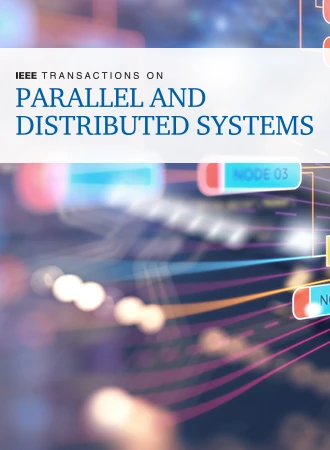基于时间空间信息的点云视频识别加速框架
IF 5.6
2区 计算机科学
Q1 COMPUTER SCIENCE, THEORY & METHODS
IEEE Transactions on Parallel and Distributed Systems
Pub Date : 2023-10-13
DOI:10.1109/TPDS.2023.3323263
引用次数: 0
摘要
在点云视频识别(PVR)任务中,深度神经网络(DNN)已被广泛用于提高准确性。然而,由于需要处理的点和帧的数量不断增加,实时处理受到阻碍。点云使用多个点表示三维形状的离散对象。因此,这些点在视图空间中往往表现出不均匀的分布,导致每个点云帧内具有很强的空间相似性。利用这一观察结果,本文介绍了PRADA,一种通过动态近似的点云识别加速算法。PRADA近似并消除了相似局部对的计算,并通过复制不同局部对的特征来恢复它们的结果,以实现可忽略的精度损失的加速。此外,考虑到点云帧的缓慢变化导致多个帧中的点之间的高度时间相似性,我们设计了点云视频识别加速算法PointV,以最大限度地减少时域中相似点的不必要计算。此外,我们提出了PRADA和PointV架构来加速PRADA算法和PointV算法。这两种体系结构可以集成以获得更高的性能改进。我们在各种数据集上的实验表明,与1080TI GPU相比,PRADA平均实现了约$7倍的加速。此外,实验结果表明,与1080TI GPU相比,PointV架构和集成架构分别可以实现11.7美元和13.9美元的性能改进,精度可接受。本文章由计算机程序翻译,如有差异,请以英文原文为准。
A Point Cloud Video Recognition Acceleration Framework Based on Tempo-Spatial Information
In point cloud video recognition (PVR) tasks, deep neural networks (DNNs) have been widely adopted to enhance accuracy. However, real-time processing is hindered due to the increasing volume of points and frames that require processes. Point clouds represent 3D-shaped discrete objects using a multitude of points. Consequently, these points often exhibit an uneven distribution in the view space, resulting in strong spatial similarity within each point cloud frame. Taking advantage of this observation, this article introduces PRADA, a
P
oint Cloud
R
ecognition
A
cceleration algorithm via
D
ynamic
A
pproximation. PRADA approximates and eliminates the similar local pairs’ computations and recovers their results by copying dissimilar local pairs’ features for speedup with negligible accuracy loss. Furthermore, considering the slow changes in point cloud frames that lead to the high temporal similarity among points across multiple frames, we design PointV, a
Point
Cloud
V
ideo Recognition Acceleration algorithm, to minimize unnecessary computations of similar points in the temporal domain. Moreover, we propose the PRADA and PointV architectures to accelerate the PRADA and PointV algorithms. These two architectures can be integrated to gain higher performance improvement. Our experiments on a wide variety of datasets show that PRADA averagely achieves about
$7\times$ $11.7\times$ $13.9\times$
求助全文
通过发布文献求助,成功后即可免费获取论文全文。
去求助
来源期刊

IEEE Transactions on Parallel and Distributed Systems
工程技术-工程:电子与电气
CiteScore
11.00
自引率
9.40%
发文量
281
审稿时长
5.6 months
期刊介绍:
IEEE Transactions on Parallel and Distributed Systems (TPDS) is published monthly. It publishes a range of papers, comments on previously published papers, and survey articles that deal with the parallel and distributed systems research areas of current importance to our readers. Particular areas of interest include, but are not limited to:
a) Parallel and distributed algorithms, focusing on topics such as: models of computation; numerical, combinatorial, and data-intensive parallel algorithms, scalability of algorithms and data structures for parallel and distributed systems, communication and synchronization protocols, network algorithms, scheduling, and load balancing.
b) Applications of parallel and distributed computing, including computational and data-enabled science and engineering, big data applications, parallel crowd sourcing, large-scale social network analysis, management of big data, cloud and grid computing, scientific and biomedical applications, mobile computing, and cyber-physical systems.
c) Parallel and distributed architectures, including architectures for instruction-level and thread-level parallelism; design, analysis, implementation, fault resilience and performance measurements of multiple-processor systems; multicore processors, heterogeneous many-core systems; petascale and exascale systems designs; novel big data architectures; special purpose architectures, including graphics processors, signal processors, network processors, media accelerators, and other special purpose processors and accelerators; impact of technology on architecture; network and interconnect architectures; parallel I/O and storage systems; architecture of the memory hierarchy; power-efficient and green computing architectures; dependable architectures; and performance modeling and evaluation.
d) Parallel and distributed software, including parallel and multicore programming languages and compilers, runtime systems, operating systems, Internet computing and web services, resource management including green computing, middleware for grids, clouds, and data centers, libraries, performance modeling and evaluation, parallel programming paradigms, and programming environments and tools.
 求助内容:
求助内容: 应助结果提醒方式:
应助结果提醒方式:


